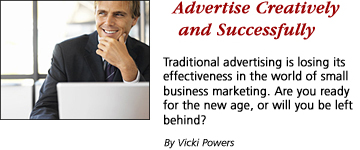|
If you examine the intersection between modern media and business, it might appear that small companies are forsaking traditional advertising. After all, digital media is completely changing the way small businesses market themselves. Buy Ad Space Online Let Blogs and Rich Media Do the Talking “It allows lower-cost options to build a brand, rather than something traditional like TV commercials,” Betoni says. “Online [advertising] can level the playing field and allow small business to put out something typically very effective with fewer resources. You also can learn exactly how effective your advertising is by watching ‘time spent with the ad’ and the ‘interaction rate.’” Blogs—which allow people to post online journal entries for others to read—are another appropriate advertising medium for small businesses that want to get online, especially those who want to reach movers and shakers who can write about their site or services. They are gaining momentum, as blog advertising accounted for $16.6 million, or 81 percent, of user-generated media’s total spending in 2005, according to PQ Media, a Connecticut-based research firm. Robb Hecht, brand blogger of Media 2.0, an IMC Strategies consulting blog, stresses the importance of including blogging and social networking into any paid media advertising buys your business makes. “Earning the endorsement of past and potential customers online via business blogging can drive a lot of credible traffic to your Web site,” he says. Fidelibus at Three Chickadees says her company targets combination ad/discussion site blogs. She says that finding a blog that focuses on the type of person that fits your product profile can be great for developing your customer base. Podcasting—the distribution of multimedia files such as a radio programs over the Internet—offers another advertising option to reach the highly engaged, and highly coveted, market of 18- to 34-year-olds. PQ Media estimates that podcast advertising will jump past blogs—from $3.3 million in 2005 to $327 million in 2010—as the largest category of user-generated media by 2010. Generate Local Buzz Miguel Zabludovsky, owner, president and CEO of Slate NYC Inc. in New York, opts for creativity in advertising his luxury, eco-friendly laundry service. Take his fall advertising campaign, “Permission to Get DirtyTM,” for example: Slate NYC will leave underwear in Laundromat dryers as if it were forgotten; the clothing will be printed with the company’s slogan and Web address to introduce its target market to its service. The campaign is cheap and potent. “I think actually not having money makes you a lot more creative, which in the end gives you much better advertising and effective advertising,” Zabludovsky says. Slate NYC’s mention in DailyCandy, a local opt-in daily e-mail highlighting cool stuff in New York, is what really put his clothes cleaning company on the map. “It’s a great example of medium and message fitting together to produce great results,” Zabludovsky says. His target audience is professional people working long hours and willing to pay for convenience. DailyCandy’s readers are exactly Slate’s target market and 80 customers signed up for its $200-per-month service the day the company appeared in the popular e-mail blast. Lori Shrum, owner of high-end fabric retailer April Grace Interiors & Fabrics in Mooresville, N.C., suggests going local, too. She analyzed her target audience to determine its buying habits, what it reads and what it wanted when she opened for business in May 2005. Her niche selling high-end, home interior fabrics attracts a high-end consumer, so she worked to reflect that message. “I tried to make sure I presented myself in a light that was very upscale, very professional, and to advertise in venues that would best represent that,” she says. “When you start a business, you don’t want to invest a lot of advertising dollars in things that don’t work.” By September 2005, Shrum began advertising in national home design magazines such as Beautiful Home, Windows & Walls, House Beautiful and Decorating. She says it was risky to take out national advertising, and admits that while national ads proved beneficial for customer leads, they didn’t turn out as many successful clients. On the other hand, advertising in Today’s Custom Home, a local quarterly publication, has generated some of Shrum’s best advertising leads. Having a local presence and being within a 50-mile radius, she says, has helped generate more substantial clients. |
|
 |
|||
